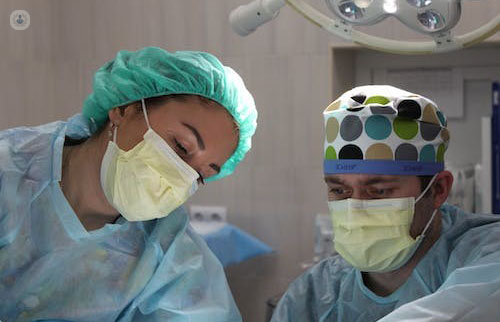Understanding acoustic neuroma: A comprehensive guide
Escrito por:In his latest online article, Mr Andrew Kay gives us his insights into acoustic neuroma. He discusses the signs, how it develops, when surgery is considered, what the surgery entails, the treatment and the prognosis.

What are the signs of an acoustic neuroma?
The signs of acoustic neuroma can be rather subtle in the beginning. Individuals might not detect numerous symptoms initially due to the gradual and slow onset, typically resulting in hearing impairment on one side. Patients tend to observe hearing loss either on the right or left side. On occasion, this is subsequently linked to a persistent sound in the ear known as tinnitus. Occasionally, it is accompanied by an issue concerning their equilibrium. In cases where the tumours are bigger, other symptoms may emerge; however, the majority of acoustic neuromas are relatively small growths.
How and why do these acoustic neuromas develop?
The "how" aspect is comparatively straightforward as they are called acoustic neuromas, though they are alternatively known as vestibular schwannomas. A schwannoma refers to a growth originating from the schwann cells that offer insulation to the nerve's external layer. Consequently, there is a gradual growth of these schwann cells, leading to an increase in their quantity. This results in the development of a swelling on the nerve, eventually culminating in a growth termed a schwannoma or a neuroma.
Due to the manifestation of hearing impairment, it was historically referred to as an acoustic neuroma, as it was previously believed to stem from the hearing nerve. However, in the vast majority of instances, it actually arises from the balance nerve, known as the vestibular nerve.
When is surgery considered for this condition?
Surgery is typically not required for the majority of individuals with acoustic neuroma, as most patients present with a small tumour. The majority of these cases involve non-aggressive growths due to their benign nature.
Nevertheless, a subset of patient’s experience tumour growth that is either rapid or instigates pronounced problematic symptoms, or leads to pressure on the brain stem or blockage of the fluid circulation within the brain. It is these instances that necessitate surgical intervention due to the tumour's dimensions and rapid expansion.
What does the surgery of this condition entail and how do we preserve the facial nerve function?
The surgical procedure is extensive and of considerable duration. It is performed under general anaesthesia, ensuring the patient remains unconscious throughout the operation. The process entails an incision situated behind the ear, followed by the creation of an opening in the bone. This opening facilitates access to the tumour located within the cranial cavity, where the tumour abuts the nerve connecting the cranial cavity to the lateral aspect of the brainstem.
Typically, the tumour is closely related to nerves governing facial movement, sensory perception in the face, and regulation of swallowing functions. Throughout the surgery, we are able to monitor these nerves, employing this approach to help determine the most effective means of safeguarding them from potential harm during the process of tumour removal.
How is the follow-up treatment and monitoring of the condition?
Following the procedure, remnants of the tumour typically remain in small quantities. Frequently, a slight residue of the tumour persists, although this constitutes a minor portion necessitating surveillance through periodic scans across subsequent years. Should these scans reveal any expansion, alternative courses of treatment can be contemplated for such instances, ideally preventing the need for additional surgery. However, to oversee the situation, an annual scanning routine is customary to assess the presence of any growth. If growth is detected, treatment options like stereotactic radiotherapy may be proposed.
What is the prognosis of acoustic neuroma?
The outlook for acoustic neuroma is favourable. This is a benign condition, and in most instances, surgery is unnecessary. For small growths that expand, non-surgical remedies like stereotactic radiotherapy offer highly efficient treatment. However, substantial tumours often necessitate surgical intervention, and if we manage to extract the majority of the tumour without significant complications, patients can attain an exceptional standard of life quality.
Mr Andrew Kay is a highly respected neurosurgeon with over 30 years of experience. You can book an appointment with Mr Kay on his Top Doctors profile.


